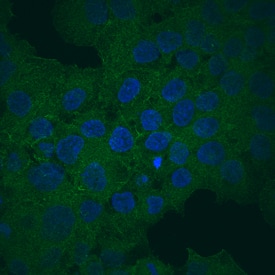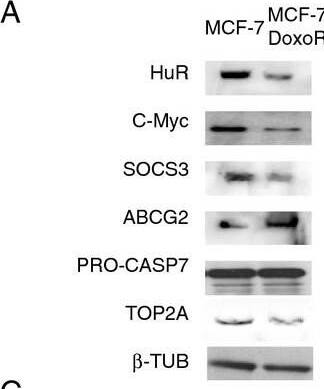Human ABCG2 Antibody
R&D Systems, part of Bio-Techne | Catalog # MAB995


Conjugate
Catalog #
Key Product Details
Species Reactivity
Validated:
Human
Cited:
Human, Mouse
Applications
Validated:
CyTOF-ready, Flow Cytometry, Immunocytochemistry
Cited:
Flow Cytometry, Immunocytochemistry, Neutralization, Western Blot
Label
Unconjugated
Antibody Source
Monoclonal Mouse IgG2B Clone # 5D3
Product Specifications
Immunogen
3T3 cells transduced with human ABCG2
Specificity
Detects human ABCG2 in flow cytometry and immunocytochemistry.
Clonality
Monoclonal
Host
Mouse
Isotype
IgG2B
Scientific Data Images for Human ABCG2 Antibody
ABCG2 in JAR Human Cell Line.
ATP-Binding Cassette Transporter G2 (ABCG2) was detected in immersion fixed JAR human choriocarcinoma cell line using Mouse Anti-Human ABCG2 Monoclonal Antibody (Catalog # MAB995) at 10 µg/mL for 3 hours at room temperature. Cells were stained using the NorthernLights™ 493-conjugated Anti-Mouse IgG Secondary Antibody (green; NL009) and counterstained with DAPI (blue). View our protocol for Fluorescent ICC Staining of Cells on Coverslips.ABCG2 in Human ABCG2 transfected CHO Chinese Hamster Cell Line.
ABCG2 was detected in immersion fixed Human ABCG2 transfected CHO Chinese hamster ovary cell line using Mouse Anti-Human ABCG2 Monoclonal Antibody (Catalog # MAB995) at 10 µg/mL for 3 hours at room temperature. Cells were stained using the NorthernLights™ 557-conjugated Anti-Mouse IgG Secondary Antibody (red; NL007) and counterstained with DAPI (blue). View our protocol for Fluorescent ICC Staining of Cells on Coverslips.Detection of ABCG2 in RPMI 8226 cells by Flow Cytometry
RPMI 8226 cells were stained with Mouse Anti-Human ABCG2 Monoclonal Antibody (Catalog # MAB995, filled histogram) or isotype control antibody (Catalog # MAB0041, open histogram) followed by Phycoerythrin-conjugated Anti-Mouse IgG Secondary Antibody (Catalog # F0102B). View our protocol for Staining Membrane-associated Proteins.Applications for Human ABCG2 Antibody
Application
Recommended Usage
CyTOF-ready
Ready to be labeled using established conjugation methods. No BSA or other carrier proteins that could interfere with conjugation.
Flow Cytometry
0.25 µg/106 cells
Sample: Human ABCG2 transfected CHO-S cells; RPMI 8226 human multiple myeloma cell line
Sample: Human ABCG2 transfected CHO-S cells; RPMI 8226 human multiple myeloma cell line
Immunocytochemistry
8-25 µg/mL
Sample: Immersion fixed JAR human choriocarcinoma cell line and Human ABCG2 transfected CHO Chinese hamster ovary cell line
Sample: Immersion fixed JAR human choriocarcinoma cell line and Human ABCG2 transfected CHO Chinese hamster ovary cell line
Formulation, Preparation, and Storage
Purification
Protein A or G purified from hybridoma culture supernatant
Reconstitution
Reconstitute at 0.5 mg/mL in sterile PBS. For liquid material, refer to CoA for concentration.
Formulation
Lyophilized from a 0.2 μm filtered solution in PBS with Trehalose. *Small pack size (SP) is supplied either lyophilized or as a 0.2 µm filtered solution in PBS.
Shipping
Lyophilized product is shipped at ambient temperature. Liquid small pack size (-SP) is shipped with polar packs. Upon receipt, store immediately at the temperature recommended below.
Stability & Storage
Use a manual defrost freezer and avoid repeated freeze-thaw cycles.
- 12 months from date of receipt, -20 to -70 °C as supplied.
- 1 month, 2 to 8 °C under sterile conditions after reconstitution.
- 6 months, -20 to -70 °C under sterile conditions after reconstitution.
Background: ABCG2
References
- Chaudhary, P.M. and I.B. Roninson (1991) Cell 66:85.
- Sorrentino, B.P. et al. (1995) Blood 86:491.
- Pallis, M. and N. Russell (2000) Blood 95:2897.
- Johnstone, R.W. et al. (1999) Blood 93:1075.
- Doyle, L.A. et al. (1998) Proc. Natl. Acad. Sci. USA 95:15665.
- Zhou, S. et al. (2001) Nat. Medicine 7:1028.
- Hrycyna, C.A. et al. (1998) Biochem. 37:13660.
- Bunting, K.D. (2002) Stem Cells 20:11.
Long Name
ATP-binding Cassette Transporter G2
Alternate Names
ABCP, BCRP, CD338, MXR
Entrez Gene IDs
9429 (Human)
Gene Symbol
ABCG2
Additional ABCG2 Products
Product Documents for Human ABCG2 Antibody
Product Specific Notices for Human ABCG2 Antibody
For research use only
